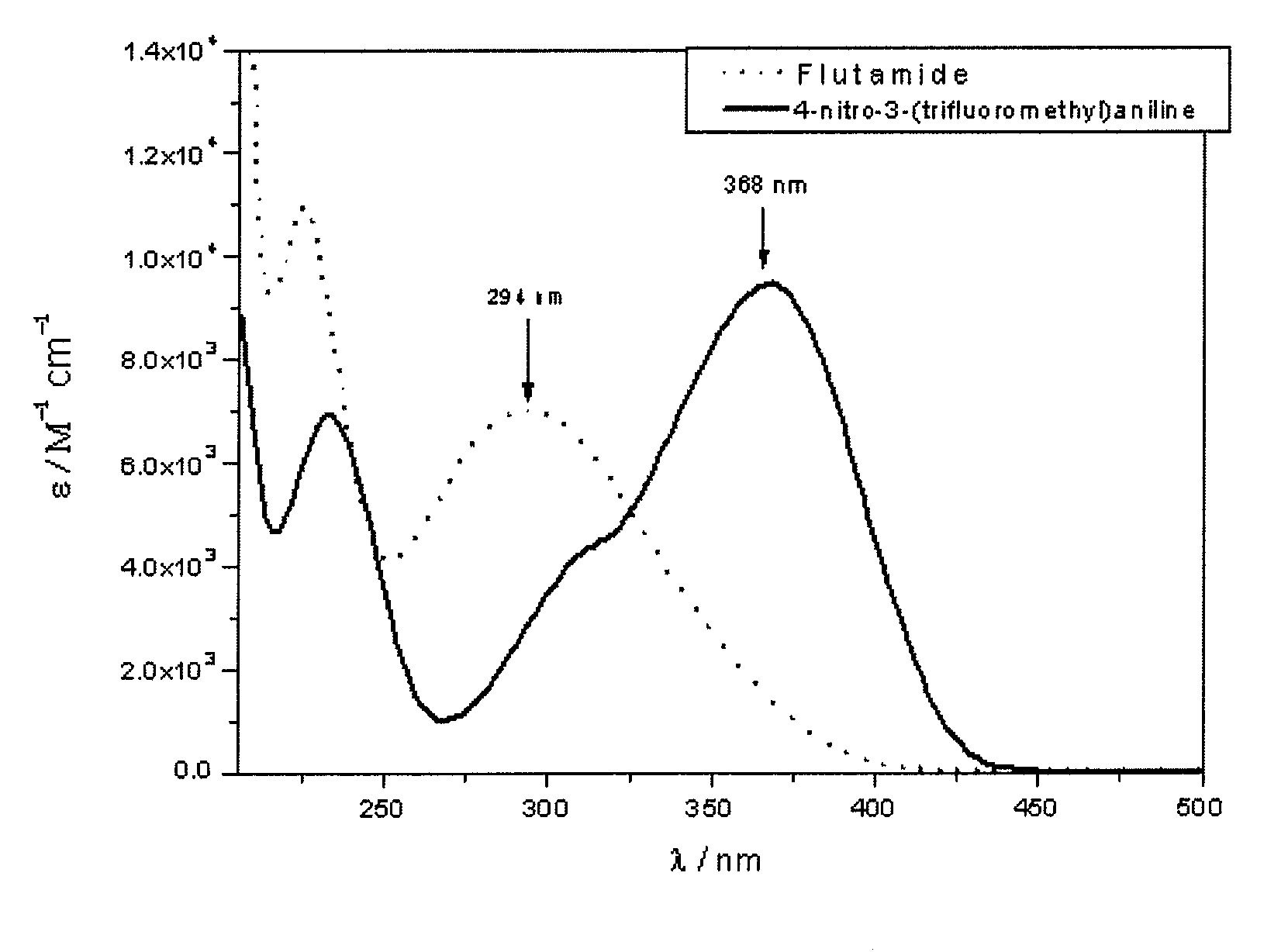Use of nitroaniline derivatives for the production of nitric oxide
a technology of nitroaniline and nitric oxide, which is applied in the direction of nitro compound active ingredients, photosensitive materials, instruments, etc., can solve the problems of significant adverse cardiac effects, tachycardia, heart palpitations, and other side effects, and achieve the effect of low cos
- Summary
- Abstract
- Description
- Claims
- Application Information
AI Technical Summary
Benefits of technology
Problems solved by technology
Method used
Image
Examples
example 1
No Photo-Release of 4-Nitro-5-(trifluoromethyl)aniline
[0101]4-Nitro-5-(trifluoromethyl)aniline was dissolved in methanol and the solution was irradiated in a quartz cuvette with 8 lamps emitting radiations with wavelength of 350 nm for 2 hours. The absorbance of the solution was measured every 30 minutes.
[0102]It was observed a progressive reduction of the absorbance peak in the band having the lowest energy associated to an increase of the absorbance peak in the band having the highest energy (FIG. 3)
[0103]In order to demonstrate the NO release in solution, the Damiani method (P. Damiani, G. Burini, Talanta 1986, vol. 33, page 649) conveniently modified by Misko (T. Misko, R. J. Schilling, D. Salvemini, W. Moore, M. Currie, Anal. Biochem. 1993, vol. 214, page 11) was used. It allows the indirect determination of NO by measuring nitrite levels. In particular, NO is an highly reactive gas that, in the presence of water, forms an equimolar mixture of nitrites and nitrates. Nitrites, r...
example 2
NO Photo-Releasing of 10-(3-(trifluoromethyl)-4-Nitrophenylamino)decan-1-thiol
[0107]10-(3-(trifluoromethyl)-4-Nitrophenylamino)decan-1-thiol was dissolved in a CH3OH:H2O (10%) solution. This solution was irradiated in a quartz cuvette with 8 lamps emitting radiations with wavelength of 350 nm for 35 minutes. The absorbance of the solution was measured every 30 minutes (FIG. 5).
[0108]300 μl of a DAN saturated solution in HCl 0.6 M were added to 3 ml of the irradiated solution of 10-(3-(trifluoromethyl)-4-Nitrophenylamino)decan-1-thiol followed by heating at 50° C. for 20 minutes.
[0109]Subsequently, 1 ml of NaOH was added to 1 ml of the solution in order to obtain naphthotriazole ions. The fluorescent spectrum of the solution thus obtained revealed the presence of nitrites and therefore the formation of NO after irradiation of 10-(3-(trifluoromethyl)-4-Nitrophenylamino)decan-1-thiol (FIG. 6).
[0110]As shown in FIG. 6, emission peaks of 1-naphtotriazole were clearly identified.
example 3
Preparation of Pt-Nanoparticles Functionalized with 10-(3-(trifluoromethyl)-4-Nitrophenylamino)decan-1-thiol
[0111]Pt-nanoparticles were prepared according to the scheme below.
[0112]These nanoparticles are soluble in water. TEM analysis revealed the presence of particles having a diameter of about 1 nm.
[0113]The functionalization of Pt-nanoparticles as described above with 10-(3-(trifluoromethyl)-4-Nitrophenylamino)decan-1-thiol may be carried out according to the scheme below.
[0114]FIG. 7 reports the absorption spectrum of the photoactive Pt-nanoparticles.
[0115]The spectrum clearly shows the typical plasmon absorption band of Pt along with the typical absorption of the photoactive unit at about 420 nm. This proves that the above schemed synthesis was effective.
[0116]The NO photo-release of the nanoparticles functionalized with 10-(3-(trifluoromethyl)-4-Nitrophenylamino)decan-1-thiol was measured using fluorimetric assay based on 2,3-diaminonaphthalene (DAN) [T. P. Misko, R. J. Schil...
PUM
| Property | Measurement | Unit |
|---|---|---|
| wavelength | aaaaa | aaaaa |
| wavelength | aaaaa | aaaaa |
| wavelength | aaaaa | aaaaa |
Abstract
Description
Claims
Application Information
 Login to View More
Login to View More - R&D
- Intellectual Property
- Life Sciences
- Materials
- Tech Scout
- Unparalleled Data Quality
- Higher Quality Content
- 60% Fewer Hallucinations
Browse by: Latest US Patents, China's latest patents, Technical Efficacy Thesaurus, Application Domain, Technology Topic, Popular Technical Reports.
© 2025 PatSnap. All rights reserved.Legal|Privacy policy|Modern Slavery Act Transparency Statement|Sitemap|About US| Contact US: help@patsnap.com



